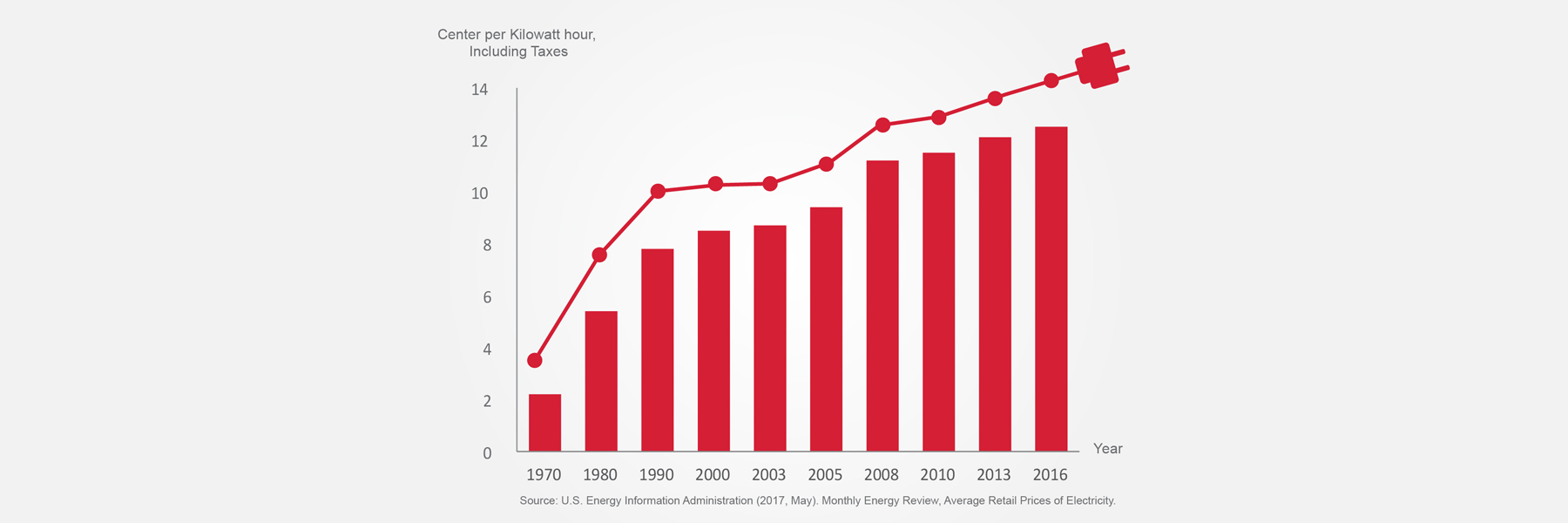
The U.S. Energy Information Administration (EIA) has predicted that residential electricity costs will continue to rise into 2018.1 This is not the best news for homeowners who have enjoyed lower electricity prices for the past few years - especially for those with older, substandard efficiency air conditioning systems!
Just ten years ago, the average U.S. residential electricity price was approximately 11.07¢ per kilowatt-hour*. The EIA forecasts the July 2018 price to be near 13.33¢ per kilowatt-hour* – that’s over a 20% increase in 10 years.1
However, there is good news too! If you are in the market for a new air conditioner, there are energy-efficient systems with advanced features that can help reduce electricity bills and improve indoor comfort.

Increased Seasonal Energy Efficiency Ratio
To understand the energy-efficiency of an air conditioning system, you need to understand Seasonal Energy Efficiency Ratio or SEER. This number measures the annual energy consumption and efficiency of the unit’s cooling ability in typical day-to-day use. Currently, the minimum U.S. SEER rating required for central air conditioners is 14 in the South and Southwest regions and 13 in the North.
If your air conditioning system was installed before 2006, it could have SEER ratings of 10 or less. A new, higher efficiency air conditioner may be able to save you on energy costs when compared to a lower SEER unit.
The higher the SEER rating, the less energy an air conditioning unit will use to operate.
When researching high-efficiency air conditioners with a high SEER number, you may find that these specific units include additional features that provide premium cooling performance and money-saving operation.
Two-Stage and Variable Speed Cooling
Certain high-efficiency air conditioners use two-stage or variable speed technology that offers part-load efficiency. The ability to match operational speeds to cooling needs allows a unit to adapt to the particular load requirements in an energy-efficient manner.
If you lower your thermostat or control system more than a few degrees, your air conditioner’s compressor and circulating fan will operate at 100% cooling capacity to reach the desired temperature. If your air conditioner only needs to maintain the set temperature, it may not need to run at 100%! This is where two-stage or variable speed technology comes in! A low-stage demand from the thermostat can result in up to 35% speed reductions at both the compressor and indoor unit circulating fan. Two-stage cooling may result in extended operation at a low speed, providing improved indoor comfort, and using less electricity than single-stage systems.
Variable-speed cooling is driven by a variable-speed compressor that can adjust output to match the load requirement. This type of compressor provides premium cooling performance which can result in lower energy bills when compared to a single-stage compressor. Because the unit does not have to start and stop as frequently, it uses less energy than a standard AC would use.
Let’s Review
Despite the increase in electricity costs, it may be possible to save energy while cooling your indoor spaces. Yet, a high-efficient air conditioner with advanced technology is only one piece of the puzzle. If other key energy-efficient solutions are ignored, your energy bills may still be higher than you would like. Additional factors that can influence cooling efficiency levels include, but are not limited to:
- Local climate
- Thermostat or control system settings
- Ductwork
- AC installation and maintenance
- Insulation and construction methods
- Windows and doors
If you want to trim costs associated with indoor cooling, talk to your local professional or licensed HVAC dealer.
1 Short-Term Energy Outlook, January 2017. (n.d.). Retrieved from US Energy Information Administration: https://www.eia.gov/outlooks/steo/report/electricity.cfm
